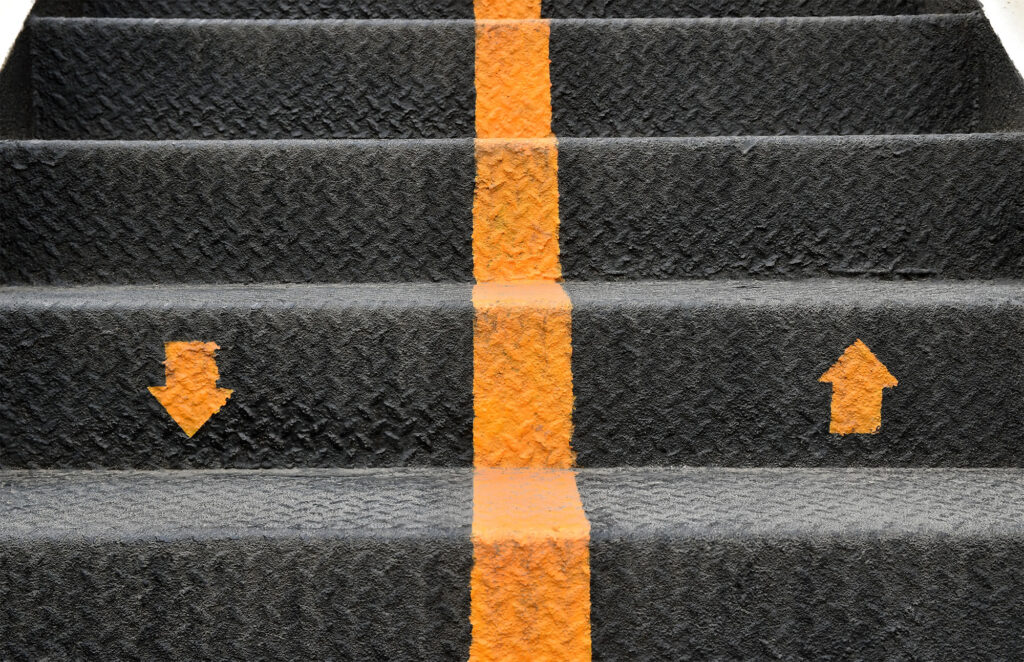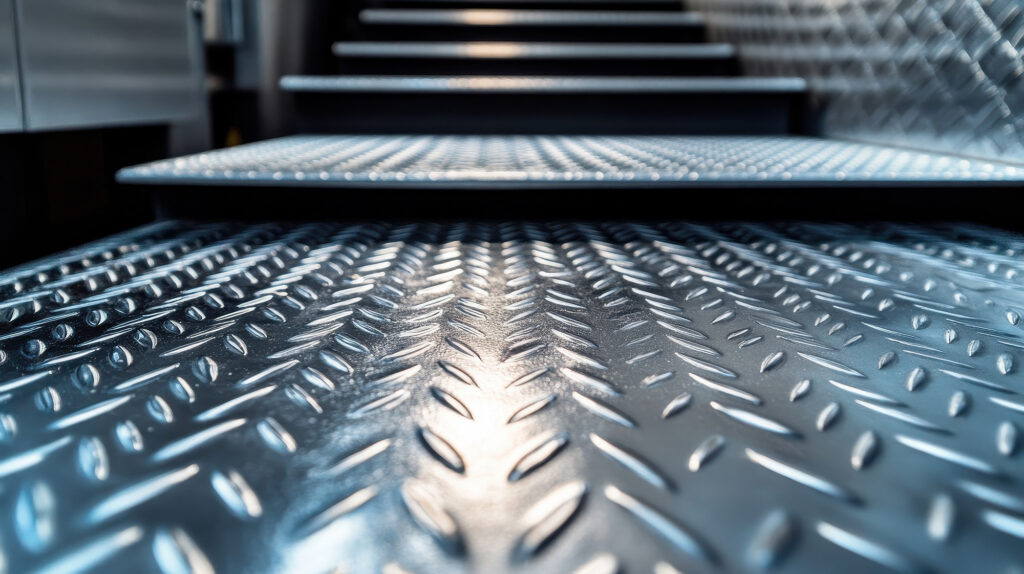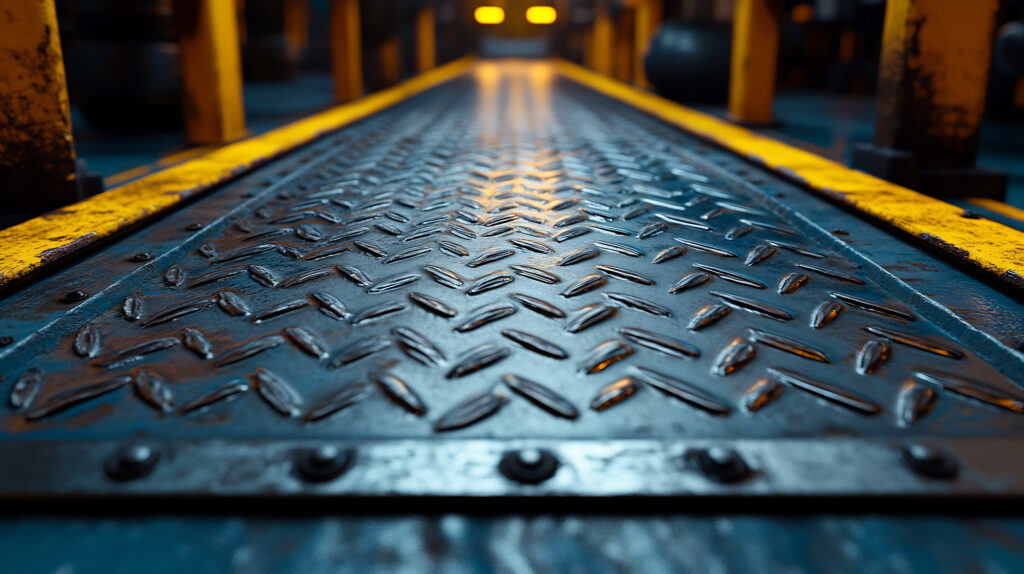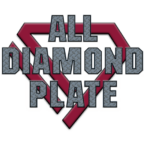Stairs & Catwalks
Diamond plate, also known as tread plate or checker plate, is a type of metal with a raised, patterned surface designed to increase traction and reduce the risk of slipping. Its distinctive diamond-shaped pattern makes it a popular material choice for various applications where safety and durability are critical, particularly in environments where surfaces are exposed to moisture, oils, or heavy foot traffic. One of the most common uses of diamond plate is on stairs and catwalks, where it serves as an effective anti-slip surface. Let’s explore in detail how diamond plate enhances safety on stairs and catwalks, improving traction and reducing the risk of slips and falls.
Anti-Slip Properties
The primary benefit of using diamond plate on stairs and catwalks is its enhanced anti-slip properties. The raised diamond pattern provides a rough texture on the surface, significantly improving traction for people walking on these surfaces. This pattern creates multiple points of contact between shoes or boots and the surface, preventing slips, even in wet or greasy conditions. For stairs, where the potential for a fall is higher due to the change in elevation and the concentrated pressure on each step, the non-slip texture of diamond plate ensures that each step is more secure. This is especially important in industrial environments, where workers are often moving between levels in conditions where water, oils, or other slippery substances may be present. The raised diamonds, or checks, act as a grip, making it harder for individuals to lose their footing while ascending or descending. In the case of catwalks—narrow walkways often elevated above the ground—slipping can have dangerous consequences. Whether in warehouses, factories, or large facilities, catwalks are often exposed to environmental conditions that can make surfaces slick. The use of diamond plate on catwalks provides the traction necessary to reduce the risk of accidents, ensuring that workers can navigate these elevated areas with confidence and stability.Durability in Challenging Environments
Another reason diamond plate is used on stairs and catwalks is its outstanding durability. These surfaces are often subject to high foot traffic, exposure to harsh weather, and even mechanical wear, making them prone to damage over time. Diamond plate is made from tough metals like aluminum, steel, or stainless steel, all of which are known for their strength and resistance to corrosion. In industrial and commercial settings, stairs and catwalks are exposed to challenging conditions, such as exposure to water, chemicals, and dirt. Diamond plate’s ability to resist rust and corrosion makes it an ideal material for these applications. Additionally, the tough surface of diamond plate is resistant to scratches, dents, and other forms of damage that could otherwise compromise the anti-slip function of the surface. Over time, it maintains its integrity, continuing to provide a secure walking surface even under the stress of constant use.Cost-Effectiveness and Maintenance
Diamond plate is relatively low-maintenance compared to other materials that might be used on stairs and catwalks. While wood, for example, can deteriorate over time due to exposure to moisture or physical damage, diamond plate is resistant to these issues. It does not require frequent refinishing or replacement, making it a cost-effective solution for facilities looking to minimize long-term maintenance expenses. Additionally, cleaning diamond plate surfaces is relatively simple. In environments where dirt, oil, or other residues are common, the textured surface of diamond plate makes it easy to scrub away contaminants without damaging the surface. This reduces the need for complex cleaning procedures and ensures that the anti-slip properties of the material remain intact, even after prolonged exposure to heavy use.Safety in Various Industries
Diamond plate is frequently used on stairs and catwalks in a variety of industries, including manufacturing plants, warehouses, power plants, oil rigs, and construction sites. These settings often involve heavy machinery, chemicals, and other hazardous conditions that increase the risk of accidents. Workers in these environments need to navigate stairs and catwalks safely, often while carrying tools, equipment, or materials. For example, in manufacturing facilities, workers often need to ascend or descend stairs and catwalks while operating in high-traffic areas or handling potentially dangerous equipment. The presence of diamond plate significantly reduces the likelihood of accidents, improving workplace safety. Similarly, in construction or industrial settings, where heavy machinery, tools, and materials are moved regularly, the durability and anti-slip features of diamond plate ensure that stairs and catwalks remain safe even in harsh working conditions. In outdoor settings, such as oil rigs or water treatment plants, catwalks are frequently exposed to the elements, including rain, snow, and ice, all of which can create slippery conditions. Diamond plate, with its robust surface, offers superior traction compared to smooth metal surfaces, significantly reducing the risk of slips and falls in these environments.Aesthetic and Functional Appeal
Beyond its functional advantages, diamond plate also offers a certain aesthetic appeal. Its industrial, rugged look adds a sense of strength and stability to stairs and catwalks. This makes it an attractive option for facilities looking for both safety and style. Whether used in public or industrial settings, the distinctive pattern of diamond plate can add an element of design while still delivering the performance required in demanding environments. In summary, diamond plate is an essential material used on stairs and catwalks to increase traction and reduce the risk of slipping. Its textured surface provides an effective anti-slip feature that enhances safety, particularly in environments where workers are exposed to wet, oily, or slippery conditions. Additionally, diamond plate’s durability, ease of maintenance, and cost-effectiveness make it an ideal choice for a wide range of industries. Whether in a factory, warehouse, or outdoor construction site, diamond plate on stairs and catwalks plays a crucial role in minimizing the risk of falls and ensuring the safety of those who use these elevated pathways.


